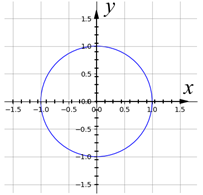How the ambiguous object works
In arts and entertainment, optical illusions have been used to create the impression of impossibility. In 2016, Professor Kokichi Sugihara in Japan found ambiguous cylinders that appear drastically different when viewed from two specific viewpoints. Suppose we have two viewers looking down on a curve floating above the \(xy-\)plane. The first viewer is a person looking at the curve, and the second viewer is in the mirror. We would like the two viewers to look down on the curve at 45-degree angles on opposite sides of the \(xy-\)plane. From the viewers’ perspectives, it looks as if they are viewing the curves and respectively, as shown in the following picture. (https://m-repo.lib.meiji.ac.jp/dspace/bitstream/10291/19877/1/jma_12_1_2.pdf)The key to the ambiguous cylinder is that the top of the cylinder is not a planar curve. This can be explained by the natural assumption of human visual perception. Natural assumption regard in visual depth three-dimensional object has width, height, and depth. As we know, two-dimensional figures don't have information on depth. But humans have the capacity to perceive a two-dimensional figure as a three-dimensional object. That's because our natural assumptions subconsciously add information on depth. When we see an illustration of an "impossible" object, we subconsciously try to perceive the object based on our natural assumptions.
Our design of an ambiguous cylinder
Our design consists of a curve of two diamonds and a curve of a circle. The curve of two diamonds is defined as following:Upper part: \[y=\left\{\begin{split} \begin{aligned} &1+x, &-1 &\le x \lt -0.5 \\ &-x, &-0.5 &\le x \lt 0\\ &x, &0 &\le x \lt 0.5 \\ &1-x, &0.5 &\le x \le 1\\ \end{aligned} \end{split}\right.\] Lower part: \[y=\left\{\begin{split} \begin{aligned} &-1-x, &-1 &\le x \lt -0.5 \\ &x, &-0.5 &\le x \lt 0\\ &-x, &0 &\le x \lt 0.5 \\ &-1+x, &0.5 &\le x \le 1\\ \end{aligned} \end{split}\right.\] The curve of a unit circle is defined as following: \[x^2+y^2=1\] We design a cylinder with OpenSCAD to show these two different curves. From the viewers’ perspectives, it looks as if they are viewing two curves respectively. The design looks like a vertical cylinder, but its section appears to be different; in one view it appears to be two diamonds, while in the other view it appears to a circle.
Why to use this design
- The two curves in this design are different enough to show the ambiguous cylinder illusion. Our design looks like a circular cylinder from the front and a two-diamond cylinder in the mirror. It is a magic phenomenon. The direct views of the objects and their mirror images generate quite different interpretations of the 3D shapes. We cannot correct our interpretations although we logically know that they come from the same objects. Even if the object is rotated in front of a viewer, it is difficult to understand the true shape of the object, and thus the illusion does not disappear.
- The unusual visual effects of ambiguous cylinder illusion might be useful. At least upon one's first encounter with ambiguous cylinders, they are surprising and mysterious. Optical illusions including ambiguous cylinders are potential resources for new products in many fields such as education, architecture, art, entertainment, advertising, and tourism. In the above design, we investigate the magic phenomenon of ambiguous cylinder illusion. This helps us to better understand the process of human visual perception.





Comments
Post a Comment